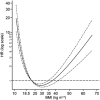The relationship between body size and mortality in the linked Scottish Health Surveys: cross-sectional surveys with follow-up
- PMID: 20921963
- PMCID: PMC3117149
- DOI: 10.1038/ijo.2010.207
The relationship between body size and mortality in the linked Scottish Health Surveys: cross-sectional surveys with follow-up
Abstract
Objective: To investigate the relationship between body mass index (BMI), waist circumference (WC) or waist-hip ratio (WHR) and all-cause mortality or cause-specific mortality.
Design: Cross-sectional surveys linked to hospital admissions and death records.
Subjects: In total, 20,117 adults (aged 18-86 years) from a nationally representative sample of the Scottish population.
Measurements: Cox proportional hazards models were used to estimate hazard ratios (HRs) for all-cause, or cause-specific, mortality. The three anthropometric measurements BMI, WC and WHR were the main variables of interest. The following were adjustment variables: age, gender, smoking status, alcohol consumption, survey year, social class and area of deprivation.
Results: BMI-defined obesity (≥ 30 kg m(-2)) was not associated with increased risk of mortality (HR = 0.93; 95% confidence interval = 0.80-1.08), whereas the overweight category (25-<30 kg m(-2)) was associated with a decreased risk (0.80; 0.70-0.91). In contrast, the HR for a high WC (men ≥ 102 cm, women ≥ 88 cm) was 1.17 (1.02-1.34) and a high WHR (men ≥ 1, women ≥ 0.85) was 1.34 (1.16-1.55). There was an increased risk of cardiovascular disease (CVD) mortality associated with BMI-defined obesity, a high WC and a high WHR categories; the HR estimates for these were 1.36 (1.05-1.77), 1.41 (1.11-1.79) and 1.44 (1.12-1.85), respectively. A low BMI (<18.5 kg m(-2)) was associated with elevated HR for all-cause mortality (2.66; 1.97-3.60), for chronic respiratory disease mortality (3.17; 1.39-7.21) and for acute respiratory disease mortality (11.68; 5.01-27.21). This pattern was repeated for WC but not for WHR.
Conclusions: It might be prudent not to use BMI as the sole measure to summarize body size. The alternatives WC and WHR may more clearly define the health risks associated with excess body fat accumulation. The lack of association between elevated BMI and mortality may reflect the secular decline in CVD mortality.
Figures

Similar articles
-
Adiposity has differing associations with incident coronary heart disease and mortality in the Scottish population: cross-sectional surveys with follow-up.Int J Obes (Lond). 2013 May;37(5):732-9. doi: 10.1038/ijo.2012.102. Epub 2012 Jul 3. Int J Obes (Lond). 2013. PMID: 22751254 Free PMC article.
-
Body mass index versus waist circumference as predictors of mortality in Canadian adults.Int J Obes (Lond). 2012 Nov;36(11):1450-4. doi: 10.1038/ijo.2011.268. Epub 2012 Jan 17. Int J Obes (Lond). 2012. PMID: 22249224 Free PMC article.
-
Cardiovascular and all-cause mortality in relation to various anthropometric measures of obesity in Europeans.Nutr Metab Cardiovasc Dis. 2015 Mar;25(3):295-304. doi: 10.1016/j.numecd.2014.09.004. Epub 2014 Sep 20. Nutr Metab Cardiovasc Dis. 2015. PMID: 25315666
-
Comparison of overall obesity and body fat distribution in predicting risk of mortality.Obesity (Silver Spring). 2009 Jun;17(6):1232-9. doi: 10.1038/oby.2008.664. Epub 2009 Feb 5. Obesity (Silver Spring). 2009. PMID: 19197258
-
The association between body mass index, waist circumference and waist-to-hip-ratio with all-cause mortality in older adults: A systematic review.Clin Nutr ESPEN. 2025 Jun;67:493-509. doi: 10.1016/j.clnesp.2025.03.051. Epub 2025 Mar 28. Clin Nutr ESPEN. 2025. PMID: 40158689
Cited by
-
Trends in overweight and obesity over 22 years in a large adult population: the HUNT Study, Norway.Clin Obes. 2013 Feb;3(1-2):12-20. doi: 10.1111/cob.12009. Epub 2013 Mar 19. Clin Obes. 2013. PMID: 23935708 Free PMC article.
-
Comparative effects of the restriction method in two large observational studies of body mass index and mortality among adults.Eur J Clin Invest. 2017 Jun;47(6):415-421. doi: 10.1111/eci.12756. Epub 2017 May 8. Eur J Clin Invest. 2017. PMID: 28380255 Free PMC article.
-
Why do thin people have elevated all-cause mortality? Evidence on confounding and reverse causality in the association of adiposity and COPD from the British Women's Heart and Health Study.PLoS One. 2015 Apr 17;10(4):e0115446. doi: 10.1371/journal.pone.0115446. eCollection 2015. PLoS One. 2015. PMID: 25884834 Free PMC article.
-
Visceral adipose tissue influences on coronary artery calcification at young and middle-age groups using computed tomography angiography.Avicenna J Med. 2015 Jul-Sep;5(3):83-8. doi: 10.4103/2231-0770.160242. Avicenna J Med. 2015. PMID: 26229760 Free PMC article.
-
Association between BMI measured within a year after diagnosis of type 2 diabetes and mortality.Diabetes Care. 2013 Apr;36(4):887-93. doi: 10.2337/dc12-0944. Epub 2012 Nov 8. Diabetes Care. 2013. PMID: 23139375 Free PMC article.
References
-
- Banegas JR, Lopez-Garcia E, Gutierrez-Fisac JL, Guallar-Castillon P, Rodriguez-Artalejo F. A simple estimate of mortality attributable to excess weight in the European Union. Eur J Clin Nutr. 2003;57:201–208. - PubMed
-
- Flegal KM, Graubard BJ, Williamson DF, Gail MH. Excess deaths associated with underweight, overweight and obesity. JAMA. 2005;293:1861–1867. - PubMed
-
- Katzmarzyk PT, Craig CL, Bouchard C. Underweight, overweight and obesity: relationships with mortality in the 13-year follow-up of the Canada fitness survey. J Clin Epidemiol. 2001;54:916–920. - PubMed
-
- Klenk J, Nagel G, Ulmer H, Strasak A, Concin H, Diem G, et al. Body mass index and mortality: results of a cohort of 1 84 697 adults in Austria. Eur J Epidemiol. 2009;24:83–91. - PubMed
Publication types
MeSH terms
Grants and funding
LinkOut - more resources
Full Text Sources
Medical

